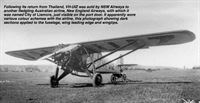Фотографии
-
Регистрационный номер: G-AUGR [2] Although the B.1 Brougham bore a recognisable family resemblance to Lindbergh’s famous Spirit of St Louis, early production examples shared surprisingly few common parts with their illustrious forebear - essentially the tail surfaces and some wing fittings; while later Broughams shared no commonality at all. Here B.1 G-AUGR awaits its next flight beside a state-of-the-art terminal in Papua New Guinea in the spring of 1928.
Самолёты на фотографии: Ryan B-1 Brougham - США - 1927
-
Регистрационный номер: G-AUGR [2] Another view of G-AUGR in Papua New Guinea. The legend beneath the passenger window reads: “Gold Air Transport Co Ltd, Salamaua, New Guinea” and the Ryan’s ungrammatical-looking name, L’Oiseau de Tropiques, is visible on the cowling’s distinctive burnished swirls - applied both for aesthetic reasons and to mask imperfections!
Самолёты на фотографии: Ryan B-1 Brougham - США - 1927
-
Регистрационный номер: G-AUIX [2] Another photograph of G-AUIX at RAAF Richmond before setting off for Wyndham, the starting point for the attempt on the Australia-England flight undertaken by Sidney Moir, Harold Owen and Frank Hurley in late 1928, during which the aircraft was written off in Greece.
Самолёты на фотографии: Ryan B-1 Brougham - США - 1927
-
Регистрационный номер: VH-UIZ [3] In a much simpler overall silver colour scheme and bearing the New England Airways legend along the fuselage and its name, City of Lismore, beneath the painted-over lower cockpit window, VH-UIZ is prepared for another flight in the early 1930s. Note that the “engine-turned” or “perlee” effect seen on the cowling is obscured by a layer of silver paint.
Самолёты на фотографии: Ryan B-1 Brougham - США - 1927
-
Регистрационный номер: VH-UIZ [3] Wally Shiers (left) and David Smith beside VH-UIZ at Wyndham in April 1930.
Самолёты на фотографии: Ryan B-1 Brougham - США - 1927
-
Регистрационный номер: G-AUIX [2] Ryan B.1 G-AUIX at RAAF Richmond, NSW, in September 1928. The title Spirit of Australia is just visible on the fuselage between the wing struts. The B.1 was similar in size to the Spirit of St Louis, with a span of 42ft Oin (12-8m) and a length of 27ft 9in (8-46m). The type was powered by a 220 h.p. nine-cylinder Wright J-5 Whirlwind.
Самолёты на фотографии: Ryan B-1 Brougham - США - 1927
-
Регистрационный номер: G-AUIZ A splendid photograph of B.1 Brougham G-AUIZ City of Sydney, with the NSW Airways Ltd logo on the door, after joining the company in November 1928. This was the second Brougham to be used in an Australia-UK flight attempt; but it flew only as far as Thailand before suffering damage in a forced landing, which unfortunately put paid to the expedition.
Самолёты на фотографии: Ryan B-1 Brougham - США - 1927
-
Регистрационный номер: VH-UIZ [3] Following its return from Thailand, VH-UIZ was sold by NSW Airways to another fledgling Australian airline, New England Airways, with which it was named City of Lismore, just visible on the port door. It apparently wore various colour schemes with the airline, this photograph showing dark sections applied to the fuselage, wing leading edge and wingtips.
Самолёты на фотографии: Ryan B-1 Brougham - США - 1927
Статьи
- -
- B.Cahill - The USAAF's Mediterranean Ferrets
- B.Lindwall - Whistling in the Dark
- B.Taghvaee - Iran's Weasel Diesels
- D.Zamansky - Airacobra: Hero of the Soviet Union
- E.Wild - Say Cheese! (2)
- J.-C.Carbonel - France's Air Pioneers: Antoine P.Filippi
- J.Forsgren - Nattjakt!
- K.Hayward - Decline & Fall
- M.Jindra - OK-JET! The Tupolev Tu-104A in Czechoslovakia
- N.Follett - Spirit of Australia
- P.Davidson - Off the Beaten Track...
- P.Jarrett - Lost & Found
- P.Lavender - Reflections on a Tragedy
- P.Vabre - From Flying to Spying (1)
- T.Buttler - Struck by Lightning







